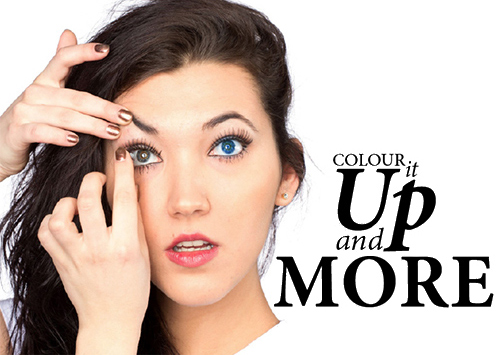Coloured contact lenses are back in the limelight. Even Oprah is wearing them on the cover of the October 2014 issue of O, The Oprah Magazine. You can’t help but be drawn to the dramatic transformation effected by her Pure Hazel lenses, one of nine shades available from the newly launched line of AIR OPTIX® COLORS contact lenses from Alcon. The patented 3-in-1 Colour Technology and silicone hydrogel material have come a long way from the unnatural-looking, dot matrix-patterned, non-disposable lenses introduced in the mid-1980s by Wesley-Jessen. Hopefully, the renewed interest in coloured contact lenses will remind eyecare practitioners that there are other applications for these medical devices – as fashion and beauty products.
Prosthesis
Prosthetic contact lenses can be life changing for patients with permanent disfigurements from congenital birth defects such as aniridia and iris coloboma, diseases such as corneal dystrophies and herpetic keratoconjunctivitis, and trauma/surgery, including lacerations, chemical burns and iridectomy.
Generally, they are used cosmetically to camouflage ocular anomalies and to make the diseased or damaged eye(s) look natural to the observer. In such cases, they help to reduce social distress and boost self-confidence.
Prosthetic contact lenses can be transparently tinted, opaque or hand-painted. They can range from something as simple as a clear lens with a black pupil to an off-axis pupil for disguising a strabismus, to an array of iris imprints, colours, pupil sizes, designs and styles. If the eye is blind, a black pupil may be used; otherwise, the pupil diameter that will provide good visual field in normal-to-bright light conditions should be selected. Sometimes, the whole lens diameter may be tinted to limit or eliminate the amount of light entering the eye, especially in patients with migraines, amblyopia, diplopia and extreme photophobia.
They are fitted for corneal coverage, centration and movement, as with any other soft or scleral contact lens, and they can be fitted with or without a prescription. In monocular cases, a digital photo can be sent to the lab for matching to the colour and iris details of the non-compromised eye.
Sports Vision
Like tinted sports goggles, custom-tinted contact lenses can help to maximize contrast, reduce glare and improve depth perception, but without the decreased field of view caused by the frame apparatus, especially for athletes who want to enhance their sports experience and/or gain a competitive advantage. As a general guide, green-grey tints increase the definition/contrast of contour cues, such as the fairway in golf, the yellow ball against the blue sky in tennis, subtle terrain details in skiing, and a brown critter against green foliage in biking/hunting. In skeet shooting, yellow or brown with red-orange tints can increase both the contrast and depth perception of the reddish-orange clay against its background, and help track, brighten and sharpen the details of low-contrast objects, such as a baseball or a soccer ball in overcast, foggy, low-light conditions.
Colour Vision Deficiencies
Colour vision deficiencies affect about 8 per cent of men and 0.4 per cent of women. Most are hereditary, while a few are caused by ocular diseases such as ARMD and glaucoma. There is no known cure for the inherited form of the condition. Art Optical has a FDA-cleared lens called the X-Chrom® lens. When worn monocularly and over the non-dominant eye, this reddish-tinted therapeutic lens can increase the perception of the red and green wavelengths of light entering the eye such that a person with dichotomous Protan and/or Deutan deficiencies can better detect or differentiate the previously ambiguous figure from the ground in pseudoisochromatic plates tests. The dominant eye without the therapeutic lens continues to have « normal » vision because the blue and yellow wavelengths are not affected.
Other Applications
Some low vision patients with significant glare/photophobic symptoms and reduced acuities from ocular diseases such as albinism, peripheral cone dystrophy and macular degeneration have benefited from red-, yellow- and green-tinted contact lenses. Blue tints have been helpful in reducing light-sensitivity symptoms in traumatic brain-injured patients and also in increasing reading speed in poor readers. Other applications include decorative/novelty or special effects contact lenses for Halloween and other special events and for the TV/movie industry.
Coloured contact lenses can be utilized in various ways, depending on the patient’s needs. Whether their intended use is as fashion accessories, for vision enhancement for recreational purposes, or as treatment for an ocular condition, they remain medical devices and require ongoing contact lens follow-ups to ensure effective lens performance and optimum corneal health.
___________________________________________________________________________________
CASSEL, M. “Changing Lives with Prosthetic Soft Lenses”, Contact Lens Spectrum, April 2010
Ciba Vision ECP Letter: “Product Discontinuation Information”, June, 2011, p. 5
BIRCH, J. “Worldwide prevalence of red-green color deficiency”, Journal of the Optical Society of America. A, Optics, image science, and vision, vol. 29, no 3, March 2012, p. 313-20
ZELTZER, H. The X-Chrom Manual, Second Edition, Massachusettes, 1982, 20 p.








